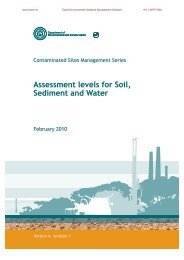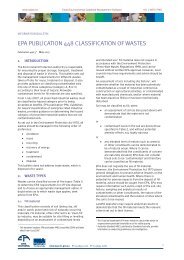Soil Generic Assessment Criteria for Human Health Risk ... - ESdat
Soil Generic Assessment Criteria for Human Health Risk ... - ESdat
Soil Generic Assessment Criteria for Human Health Risk ... - ESdat
Create successful ePaper yourself
Turn your PDF publications into a flip-book with our unique Google optimized e-Paper software.
www.esdat.net Esdat Environmental Database Management Software +61 2 8875 7948<br />
Molybdenum CAS 7439-98-7 Assessor A: Nick Struggles, AECOM Assessor B: Atkins Final review: Panel/SF<br />
Date 01/06/2009 Date 17/06/2009 Date 26/08/2009<br />
MDI Recommended MDIoral Units<br />
134.8 ug day-1 per day). MDIoral is sum of contributions from diet and drinking water.<br />
Organisation Date Media Value Units Description Reference Web link<br />
Food Standards Agency<br />
01/05/2009 mean dietary<br />
exposure <strong>for</strong> adults<br />
a) estimated 0.123-0.125<br />
b) mean <strong>for</strong> adults 1.61-1.64<br />
c) toddlers mean 4.8-4.87<br />
d) young people mean 3.01-<br />
3.05<br />
a) mg/day<br />
b), c) , d) ug/kg<br />
bw/day<br />
Justification: Mean daily intake <strong>for</strong> adults in food from FSA (1.64 ug/kg.bw/day), equivalent to 114.8μg/day assuming a 70kg adult.<br />
WHO notes concentration of Mo in drinking water are typically less than 0.01mg/L (equivalent to 0.02 mg/day <strong>for</strong> 2L consumed<br />
This is slightly higher than the exposure<br />
reported in 1994 and 1991 and 1985<br />
(0.11mg/day). These are well within the<br />
guidance level <strong>for</strong> molybdenum of<br />
0.23mg/day as stated in the EVM report and<br />
the WHO estimated daily requirement <strong>for</strong><br />
molybdenum of 0.1-0.3mg/day <strong>for</strong> adults.<br />
The mean dietary exposure <strong>for</strong> adults was<br />
estimated to be 1.61-1.64ug/kg/bw and the<br />
high level exposure was 3.03-3.08<br />
ug/kg/bw/day. Estimated intake in toddlers<br />
mean (4.8-4.87ug/kg/bw/day) and high level<br />
(7.54-8.32ug/kg/bw/day) and <strong>for</strong> young<br />
people mean (3.01-3.05ug/kg/bw/day) and<br />
high level (5.77-5.82ug/kg/bw/day).<br />
Page 15. MEASUREMENT OF THE<br />
CONCENTRATIONS OF METALS AND<br />
OTHER ELEMENTS<br />
FROM THE 2006 UK TOTAL DIET STUDY<br />
January 2009<br />
http://www.food.gov.uk/multimedia/pdfs/<br />
fsis0109metals.pdf<br />
Committee on Toxicity of<br />
Chemicals in Food, Consumer<br />
Products and the Environment<br />
(COT)<br />
01/05/2009 a) and b) food dietary<br />
intake<br />
c) max recommended<br />
level in drinking<br />
water<br />
d) WHO noted typical<br />
drinking water<br />
concentration<br />
e) Recommended<br />
daily requirement of<br />
Mo<br />
f) drinking water<br />
g) supplements<br />
h) Estimated<br />
maximum intake<br />
a) 0.11mg (mean)<br />
b) 0.21mg (97.5%ile)<br />
c) 0.07<br />
d) 0.01<br />
e) 0.1-0.3<br />
f) 0.02<br />
g) up to 0.33mg<br />
h) 0.21+0.02+0.33=0.56<br />
a) and b) mg<br />
c) and d) mg/L<br />
e) mg/day <strong>for</strong><br />
adults<br />
f) mg/day<br />
g) mg<br />
h) mg/day<br />
a) and b) Daily exposure estimates from food<br />
Source of data sources, excluding<br />
supplements, <strong>for</strong> men and women (in mg).<br />
Mean and 97.5%ile values presented.<br />
c) WHO recommended max level of Mo in<br />
drinking water<br />
d) WHO notes that the concentrations of Mo<br />
in drinking water are typically less than<br />
0.01mg/L, however, in areas near mining<br />
sites, Mo concentrations up to 0.2mg/L have<br />
been reported.<br />
e) WHO 1993 estimated daily requirement<br />
<strong>for</strong> molybdenum <strong>for</strong> adults<br />
f) drinking water - (estimated from 0.01mg/L<br />
(WHO 1993)<br />
g) supplements<br />
h) estimated maximum intake (totalled from<br />
food (97.5%ile see a), drinking water (see f)<br />
and maximum recommended supplements<br />
(see g)<br />
a) and b) MAFF 1997. quoted in Safe http://cot.food.gov.uk/pdfs/vitmin2003.pd<br />
Upper Limit on Vitamins and Minerals f<br />
(May 2003)<br />
http://cot.food.gov.uk/pdfs/vitmin200<br />
3.pdf<br />
c), d), e), f), g),<br />
h)http://cot.food.gov.uk/pdfs/vitmin20<br />
03.pdf<br />
European Food Safety Authority<br />
(EFSA)<br />
01/05/2009 Estimated dietary<br />
exposure (food and<br />
drink)<br />
50-400 (mean 128) ug day-1 Estimated Dietary exposure <strong>for</strong> Adults in UK. SCF 1993 study in EFSA 'Tolerable<br />
Upper Intake Levels <strong>for</strong> Vitamins and<br />
Minerals' 2006.<br />
http://www.efsa.europa.eu/cs/BlobSer<br />
ver/Scientific_Document/upper_level_<br />
opinions_full-part33.pdfssbinary=true<br />
www.efsa.europa.eu/en.htm<br />
Scientific Committee on Food<br />
(SCF) pre 2002<br />
01/05/2009 mean dietary intake 128 ug/day Mean dietary intake in the United Kingdom Previous source: SCF 1993 .<br />
Commission of the European<br />
Communities. Reports of the Scientific<br />
Committee <strong>for</strong> Food (thirty-first series).<br />
Nutrient and energy intakes <strong>for</strong> the<br />
European Community. Opinion<br />
Expressed on 11 December 1992.<br />
http://ec.europa.eu/food/fs/sc/scf/out<br />
89.pdf<br />
http://ec.europa.eu/fppd/fs/sc/scf/index_e<br />
n.html<br />
Original source: Mills CF, Davis, GK.<br />
1987. Molybdenum. In: Mertz W, ed.<br />
Trace Elements in <strong>Human</strong> and Animal<br />
Nutrition. 5th Ed. Vol 1. San Diego:<br />
Academic Press, 429-463.<br />
Page 1 of 2 EIC pro<strong>for</strong>ma molybdenum.xls 26/08/2009








